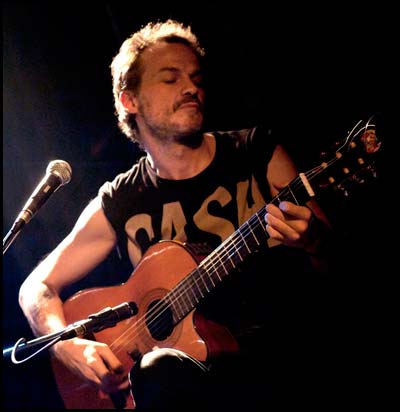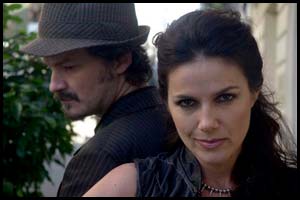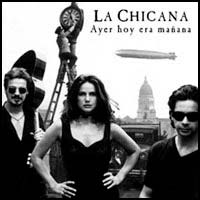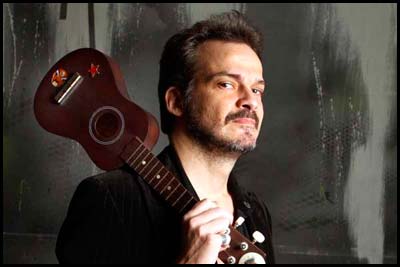By
Estol - An informal talk with Acho Estol

ou’re a sort of multi-talented guy: composer, vocalist, lyricist. Putting aside the fact that you’re the producer of your own discs, you manage your concerts. Can you establish a hierarchy for those activities? That is to say, do you think you’re more a musician than a lyricist, or more of a composer than a performer?

«Sometimes it bothers me to be regarded as a tango lyricist because I devote myself to writing lyrics, in fact, around ten days a year —spaced, of course—, it is less than 5% of my work. Composing the music of them takes a little more; sometimes I write them at the same time but, anyway, I don’t write more than ten or twelve numbers per year. I’m a fairly eclectic musician: I’m responsible for the art production of La Chicana, of my works as soloist and of a good number of discs for other people (rock, folk music, classical music), and in charge of arrangements and musical direction and I also play several instruments. I also compose and produce music for movies and take care of graphic and audiovisual aspects of La Chicana and of my Project as soloist (disc cover art, leaflets, posters, video clips) because I have always been connected with visual arts (graphic design, photography, cinema), and that was my way of making a living for years.
«I don’t think I’m more of a composer than a player because the job onstage is a reality more frequent and better paid than composition. But I do think that my best personal contribution to music is as author-composer and not as performer; In fact I neither play well any instrument, nor I like my voice very much nor I long for being onstage. I know how to lead and I’m capable of making the band sound well but the one who really contributes as interpreter is Lola (Dolores Solá)».

The cover art of your discs presents very peculiar aesthetics that even may be shocking for some people. Example: the front cover with the picture of an «estoliated dog». There is clearly a strong intention behind. Looking for a clash?
«It may be defined as «expecting a crash», but it’s an emotional shock, it’s my version of Arlt’s cross to the jaw. The idea is that you know from the beginning that the contents can be brutal or cynical, but always honest, «against all odds». They have told me about the presence of my gaze on the graphic work, a look to the camera which is almost critical. In fact, I guess that it is an emphasis on the absolute subjectivity of my work and the critical voyeurism which inspires it».
La Chicana and Las Moscas de Bar and Acho Astol are two different bands and one only true god?
«I think La Chicana is a fine band with a meticulous leader and an impressive front-woman. Las Moscas de Bar, instead, is a sporadic gathering of friends that cannibalizes the sound of La Chicana (thanks to musicians and ideology in common) but has a more playful and informal spirit, for nonprofit purposes. We choose the repertoire and arrangements more democratically and, by the way, we play the numbers of my discs as soloist and the more rock-like queer things that are not suitable for La Chicana».
You make many tours. Don’t you, Acho? How is it playing abroad? Is there any difference playing abroad and here?
 «Yes, there is if abroad or here. In brief, sometimes you feel better abroad. When journalists have researched before interviewing you. Here is very frequent to hear: “Then, you play tango. Don’t you?”. There impresarios, producers and sound engineers are impeccably serious, skilled and devoted. Here you have to adapt yourself. When the audience —generally the German and the English— with little applause at the beginning, hesitantly, get warmer as soon as they understand and comprehend the proposal, finally, end up in an ovation. An ovation that you know you achieved by hard work rather than the one you get from the start.
«Yes, there is if abroad or here. In brief, sometimes you feel better abroad. When journalists have researched before interviewing you. Here is very frequent to hear: “Then, you play tango. Don’t you?”. There impresarios, producers and sound engineers are impeccably serious, skilled and devoted. Here you have to adapt yourself. When the audience —generally the German and the English— with little applause at the beginning, hesitantly, get warmer as soon as they understand and comprehend the proposal, finally, end up in an ovation. An ovation that you know you achieved by hard work rather than the one you get from the start.
«But here’s our public, those to whom we plainly speak; those who follow us, understand us and answer us in the same language. Here we also have those that are indifferent to their own music (due to prejudice or lack of exposure) and we shout at them: tango is nice! (a thing foreigners know) because we care that they come even though if it is for the sake of discovering tango through us and then they can continue their journey with some little more sense of cultural identity».
Do you make a living with music?
 «Yes, fortunately I have been making a living with what I said in the first of my answers. When I say fortunately, I mean it. You always have to be lucky and we were. I don’t teach. Neither do I engage in banking operations, nor do I replace light bulbs, nor paint walls, nor do I make barbecues. I work on my own things».
«Yes, fortunately I have been making a living with what I said in the first of my answers. When I say fortunately, I mean it. You always have to be lucky and we were. I don’t teach. Neither do I engage in banking operations, nor do I replace light bulbs, nor paint walls, nor do I make barbecues. I work on my own things».
In an interview for El País it is said that your lyrics are studied by psychoanalysts. Did they seek for your advice to understand them better?
«A couple of professionals told me (on occasion of playing for an encounter of the Argentine Association of Psychologists) that they had used my lyrics to give examples of different kinds of psychopathologies and expressions of the subconscious. It’s not the same thing the mad woman of “Un giro extraño” than the schizoid of “De qué te vas a disfrazar”. It’s not the same thing the oneiric sensation in “Sueño de morocha” than the hallucinatory perception of “Lucho en el suelo…” It also turns out that I have quite “superego” songs and others that come straight from the id. It seems that there are many paranoid narrators and many phobic ones (I try not to psychoanalyze what I write). I don’t know if this is good or bad!»

We know that your experience in Senegal was quite strong, that you included new timbres and new instruments. How did you arrive in Senegal? Besides listening, you played. Who listened to you?
«We arrived in Senegal by the hand of a creative and spectacular cultural management by Andrea Madariaga, a very close friend and, at times, agent of La Chicana. Among others, Cheikh Lo heard us, a musician of Dakar, worshipper of the Moslem sect Baye Fall. An incredible singer, guitarist, percussionist, etc. with whom we later shared jam sessions and encounters in different places of the world. He was impressed by the familiarity of milonga, candombe and chacarera with his own rhythms. Three old little women of the Wolof ethnic group also heard us and they told us that back in the thirties for their birthday and marriage celebrations tango was danced instead of waltz —maybe adopting what was most fashionable for their colonizers— and that they had been waiting for us for a lifetime. We were the first Argentine tango group that played in Senegal».
And then we ended the talk with Acho Estol.